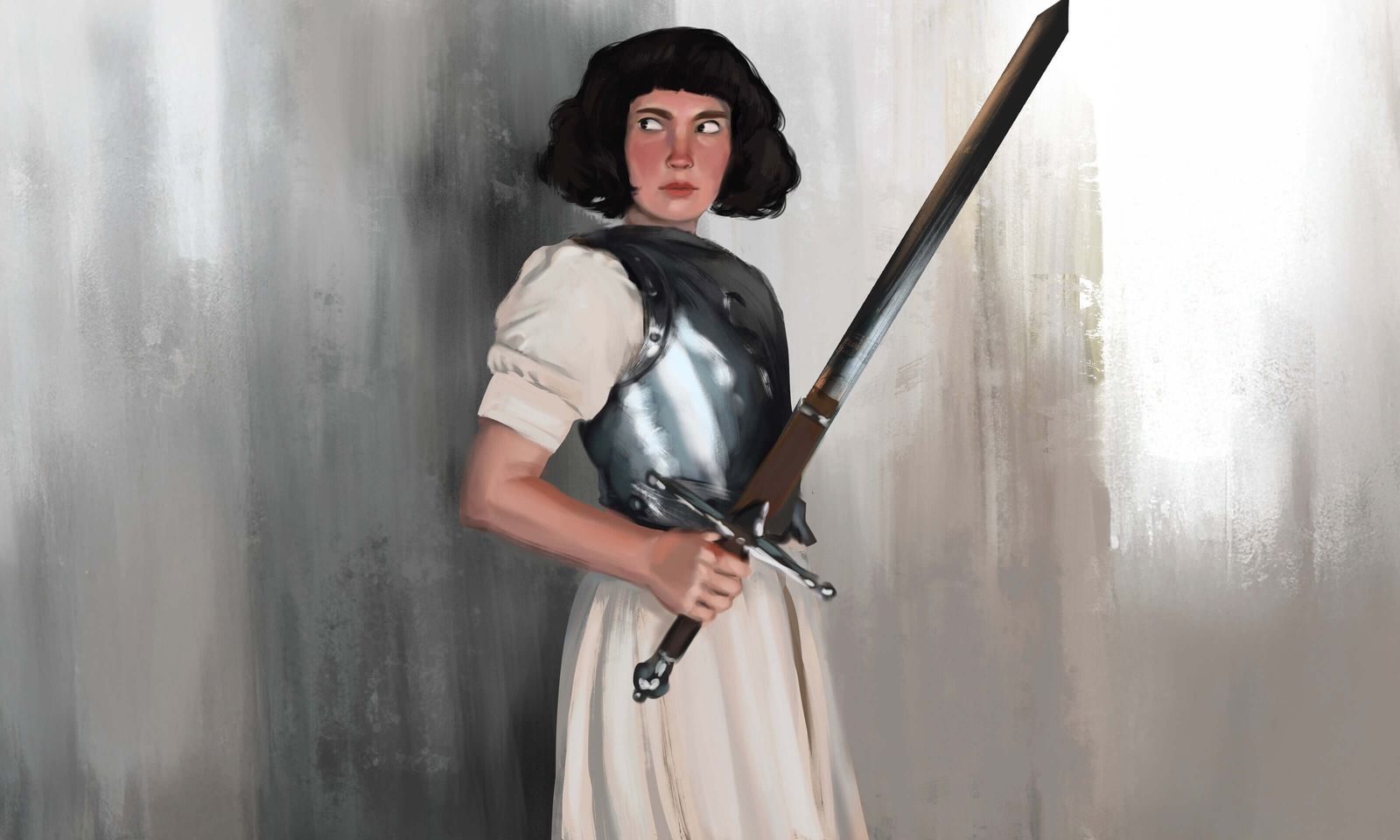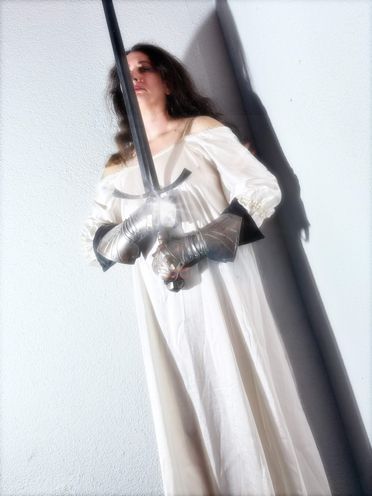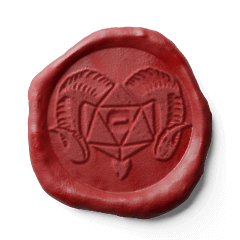Knightcore, aka castlecore, is an aesthetic that combines gleaming armor, soft, flowing fabrics, and ethereal, haunting glows. Now it is also a roleplaying game.
The world—a fantasy imagining of Mythic Britain—is a place of chaos, darkness, uncertainty. The knights are the shining beacons of hope in it.
Knightcore Characters

Characteristics
Valor. Acts of bravery and courage. Feats and weapons of war.
Endurance. Bearing suffering and pain. Staving off exhaustion and giving up.
Precision. Matters of dexterity and patience, balance and exactness.
Radiance. Inner strength manifesting as ethereal glow. Presence and charisma.
Characteristics range from -2 to +3. At character generation roll 1d6-3 four times, and assign as desired.
Hit Points
Hit points (hp) represent the measure of punishment a character can withstand before facing possible life-altering and life-threatening consequences. A starting character has 6 hp; this number may increase through advances. See Damage in the Mechanics section for more on hp.
Purity
A measure of a character’s virtue and sanctity. It is a scale ranging from depraved on the low end, to holy on the high end. Meaningful actions, as well as some powers, can shift it either way. Each stage on the scale corresponds to a bonus that is added to die rolls. On the defiled side the bonuses are quick to attain but remain modest. On the virtuous end they are hard to reach, but more impactful.
| Depraved | Start | Angelic | ||||||||||||
|---|---|---|---|---|---|---|---|---|---|---|---|---|---|---|
| - | +3 | +2 | +2 | +1 | +1 | +1 | 0 | 0 | 0 | 0 | +2 | +3 | +7 | - |
A character’s purity rating usually starts in the middle, at 0. Certain advances might adjust this.
If a character reaches either extreme of the scale, they stop being player characters and become GM characters instead. A depraved character might become a new villain, and angelic one might ascend to the heavens.
A character with a purity rating in the middle or closer to angelic is currently considered pure, whereas with a rating tending towards depraved, they are considered currently impure.

Equipment
To remain true to knightcore aesthetics (KA, see below), a character will usually limit themselves to carrying only items that add to the KA value, or at least that can be styled such that they don't reduce it (for example, wrapping a silvery chain around the neck and body to elevate it from the mundane to the stylish). Everything else can be carried by squires and camp followers, where available.
All but the smallest items have a KA modifier noted, which is negotiable with the GM, based on styling, as above. Makeup and skincare items, as well as hair products can also add to KA.
Some items, like weapons for example, might also add a modifier to characteristics.
Prices are in crowns. Starting characters have 1d100 + 200 crowns, to spend on equipment or to hoard. Below are sample items for the main categories. You're encouraged to make up more, using the ones below as guidelines.
Armor
Armor ranges between 0 and 3 maximum, and reduces incoming hp damage by that amount.
| Item | KA Modifier | Armor | Special | Price |
|---|---|---|---|---|
| Silver, scaled shoulder and arm armor | 1 | 1 | 45 | |
| Polished breastplate | 2 | 1 | 80 | |
| Ornate greaves | 1 | 1 | 40 | |
| Shining metal gloves | 1 | 1 | 30 | |
| Polished vambraces | 1 | 1 | 35 |
Weapons
Weapons deal a certain amount of damage on a hit, and often a smaller amount on a miss—usually your Valor score. A negative score counts as 0 for this, a weapon strike can never heal an opponent. Some weapons might have other effects on a miss than reduced damage.
Ammunition isn’t actively kept track off in this game. It is assumed you or your squire can recover, get, or make enough between fights. It is however possible for some opponents to inflict a condition on you that means you’ve run out.
| Item | KA Modifier | Hit | Miss | Special | Price |
|---|---|---|---|---|---|
| Gleaming langue de boeuf | 1 | 1d10+Valor | Valor | +1 Valor | 90 |
| Well-maintained longsword | 2 | 1d8+Valor | Valor | +1 Valor | 75 |
| Battered flail | 1 | 1d6+Valor | Valor | 35 | |
| Rusty dagger | -1 | 1d4+Valor | Valor | 5 | |
| Silver and pearl inlay crossbow | 1 | 1d8+Precision | Precision | 85 | |
| Backup dagger | 0 | 1d4+Valor | — | 10 |
Clothing
| Item | KA Modifier | Special | Price |
|---|---|---|---|
| Peasant’s garb | -2 | -1 Radiance | 2 |
| Heeled leather knee-high boots | 1 | +1 Precision | 40 |
| Flowing, silk dress | 2 | +1 Radiance | 90 |
| Silver crown draped with pearl necklaces | 1 | Necklaces can function as rope | 150 |
| Wine-red satin gown with puffed sleeves | 2 | 85 | |
| Embroidered velvet chemise | 2 | 70 | |
| Cotton dress | 0 | 15 |
Beauty Products
| Item | Effect | Price |
|---|---|---|
| Angelica archangelica rouge | +1 KA, 6 doses | 30 |
| Curling iron | +1 KA, 1 hour + fire to apply | 25 |
| Siren lipstick | +1 KA, 10 uses | 35 |
| Bear fat hair pomade | +1 KA, 6 uses | 20 |
| Cyclamen root foundation | +1 KA, 4 uses | 25 |
| Kohl eyeliner/shadow | +1 KA, mirror or person to apply, 6 uses, protect against the sun and the evil eye | 30 |
Miscellaneous
| Item | KA Modifier | Special | Price |
|---|---|---|---|
| Porter/page/squire | 0 | Carries unseemly and ungainly stuff for you | 50 (hire) or 10 per session |
| Regal steed | 1 | Double endurance relating to travel | 120 |
| Kit of Revestment | Special | Contains needle and thread for repairing torn garments, soap and cloth for cleaning fabrics and armor, terrycloth and metal sponge for buffing armor; 6 uses, 1 use + 1 hour repairs 1 KA | 40 |
Knightcore Aesthetics (KA)
A value derived from the relevant items that you carry that support the knightcore look, and styling that you have applied. The maximum value for this is 20, and it cannot go below 0.
The personal KA value feeds into the group knightcore aesthetics value (GKA), and this value is the average of all the personal KA values. The GKA determines the size of the chaos die (see below), as per this table:
| GKA | 0–5 | 6–10 | 11–15 | 16–20 |
|---|---|---|---|---|
| Chaos Die | d4 | d6 | d8 | d12 |
Model: Karen Reding
Advances
Beyond the look and style of characters and their purity and characteristics, it is the powers that come from these advances that sets them apart from cowering masses in this dark and chaotic world, and drives them to become the beacons of hope (or at least, strength) they were always meant to be.
Starting characters roll three times on the table, and choose two results, discarding one. Most advances can be taken multiple times, some only make sense to be taken once.
- Paragon of Heroism. Add +1 to Valor.
- Exemplar of Stoicism. Add +1 to Endurance.
- Epitome of Accuracy. Add +1 to Precision.
- Model of Splendor. Add +1 to Radiance.
- Glutton for Punishment. Add 1d4 to your hit points.
- Astonishingly Fast. Move twice as far in a combat turn, and gain an additional initiative token.
- You Wear it Well. Choose one type of equipment (e.g. swords, vambraces, dresses, etc.). This type’s KA modifier is 1 higher than normal.
- Magic. You know magic. Choose one of fairy pacts, witchcraft, or the old ways; see below for more information.
- Pure Soul. Your innocence is harder to defile than others’. Whenever you're about to reduce your purity, reduce it by 1 less (to a minimum of 1).
- Saddleborn. You are particularly adept at taming and riding creatures, and performing feats of acrobatics with them.
- Resplendent. Your radiance counts double when it comes to impressing people.
- Classically Trained. Choose a type of weapon (e.g. hammers, lances, polearms, …). The damage die for this type is stepped up by 1 for you (i.e. 1d4 becomes 1d6, 1d6 becomes 1d8, etc.).
- Prodigy of String and Needle. Whenever an item of yours would lose KA, it loses 1 less (to a minimum of 1).
- Lashwright. Your mastery of the whip doubles your chances of targets cowering, or, at least temporarily, submitting to you.
- Eerie Presence. Something about you is unusual. Animals and children immediately notice it, and get agitated when you’re near, possibly even panicking.
- Changeling. From childhood’s hour you have not been as others were—you have not seen as others saw—you could not bring your passions from a common spring. Unbeknownst even to you, you are fey (unnaturally long life, resistance to and aptitude for magic, capricious nature). Maybe you’re starting to suspect.
- Lacustrine. You share a special, mystical connection to lakes and rivers. You are a friend to hydriads, naiads, ondines, and all manner of such nymphs, possibly even mermaids and sirens. You move and breathe in water as easily as in air.
- Anemogene. Subtle winds obey your every desire, and hair and clothes blowing dramatically is your second nature. Perhaps you are truly born of the winds.
- Drawn Upon the Land. Once a session you may draw deep from the land and fully restore a character’s hit points, or remove one of their conditions.
- Peerless Knight. Once a session, for the duration of a battle, the chaos die is considered to be at its maximum value, regardless of its actual value, and all your hits do maximum damage.
Magic

Magic is very open-ended, and always demands a price. The different traditions of magic are tied to different domains within which they operate, and the price should be commensurate to the power of the spell invented or requested when cast.
When a magic advance is taken or gained, you may choose a new tradition, or choose a new domain from an existing one. In the case of fairy pacts, you may choose an additional fey to be connected to.
Fairy Pacts
You’ve encountered a faerie and ingratiated yourself with them, and you two have sealed a compact. They’ve bestowed you a token (e.g. necklace, ring, scarf, …), through which they can hear your pleas. At any point, in return for a later embarrassing, humiliating, or indecent favor, they grant you the immediate use of a spell concerning nature and seasons, glamor and enchantment, twilight and trickery, and beauty and love.
Witchcraft
You’re a member of an old coven, dating back many generations, ever passing on ancient, occult knowledge. Casting spells costs purity; not because your magic is uncouth, but because society views it so. Costs range from 1 purity for a simple spell to 3 purity for something far-reaching.
Witchcraft encompasses many domains, and each coven specializes in a limited number of them. Choose 2 from the following:
| Domain | Sample Themes |
|---|---|
| Herb and Hearth | Healing, potions, fertility, home |
| Curse and Shadow | Hexes, binding, retribution, the unseen |
| Barrow Wisdom | Speaking to the dead, necromancy |
| Moon and Mystery | Divination, intuition, illusion, secrecy |
| Transformation | Shape-shifting, alchemy, destruction and renewal |
| Fire and Desire | Passion, creation, sacrifice |
| Storm and Wind | Weather, flight, unbounded power |
| Demons and the Devil | Debauchery, possession, immoral acts |
The Old Ways
Sometimes also referred to as druidcraft, archmagery, or the art hermetic, this magic is older than witchcraft and even the faerie. Where the latter could be summarized as glamor that moves hearts, and witch magic as craft that changes things, the old ways represent wisdom that binds the world together.
Archmagery requires profound connections with bones of the land and the whims of time, which are draining to maintain. Casting a spell visibly, and sometimes dramatically, ravages the body, dealing between 1–3 hp and KA damage, depending on the spell's grandeur.
| Domain | Sample Themes |
|---|---|
| Prophecy and Time | Foresight, dreams, cycles of kings and ages |
| Stars and Fates | Cosmic alignments, conjunctions, destinies |
| Earth and Stone | Monuments, ley lines, the heart of the land |
| Beasts and Monsters | Symbolic and actual metamorphosis |
| Law and Wisdom | Knowledge of the divine and natural order |
Mechanics

Rolls
When an action could have a meaningful or dangerous outcome, roll 1d20, add the modifier from the characteristic that pertains to the action, and add your purity modifier. If the result is equal or greater than the difficulty rating (12 on average), the action succeeds. Otherwise it fails, but it should ideally fail forward, that is, create interesting complications rather than stop the narrative in its tracks.
In combat, you additionally add the current chaos die modifier to the roll.
Chaos Die
This die represents the uncertainty and the whims of the capricious world the knights navigate through. It is anything from a d4 to a d12, depending on the group knightcore aesthetic value.
At the beginning of combat, roll the die and subtract 4. This modifier applies to all attack and action rolls in the fight (not result rolls like damage or spell effects). At the beginning of each new round, it increases by 1, up to its maximum. But beware, if the chaos token comes up during the initiative draw (see below), it is re-rolled!
The chaos die modifier only affects the knights’ rolls, not the enemy’s.
Since a die cannot represent a negative number or zero, it is recommended to fashion a coin or poker chip with a plus sign on one side and minus sign on the other, and place it next to the die. And if the current result is zero, just hand the die to the GM until it changes.
Initiative
Knightcore uses a variant of the Troika! initiative system. For each knight and each enemy, place a corresponding token in a bag (or possibly multiple, depending on their powers), together with an end of round token, and a chaos token.
The GM then draws a token, and whoever’s it is takes a turn. A turn includes an action such as an attack or casting a spell, plus a short movement. Trivial actions like picking something up, opening an unlocked door, or drinking a potion that’s readily available, are considered free actions, within reason.
If the chaos token gets drawn then the chaos die is immediately re-rolled.
When the end of round token is drawn, all tokens return to the bag, the bag is thoroughly shaken, and a new rounds begins, starting with incrementing the chaos die by 1.
Attacking and Defending
In Knightcore the players roll the dice both for attacking and defending. The characteristic used depends on the action, but is often valor for close combat, precision for ranged combat and evasion, and radiance for influencing people and affecting the world in powerful ways.
Some actions or attacks may require an endurance roll to avoid additional consequences.
Damage and Knightcore Aesthetics
When you fail to evade an attack via a precision roll, you take damage to your hit points, and a lot of the time to your KA as well (if the attack ravages your clothes, for example). If your hit points are reduced to 0 exactly, you collapse (dramatically, if desired). If your hit points are reduced to a negative value, you must immediately roll endurance with a modifier equal to your current hit points. If you fail, you take a relevant condition. If you succeed, you may yet continue to fight. You must repeat this endurance roll at the beginning of round, and each time you take damage, as long as you are in negative hit points.
| Hit Points | Effects |
|---|---|
| 0 | Collapse to the ground (dramatically if desired), unable to move beyond slowly dragging yourself about. Go full damsel or damoiseau in distress if you like. |
| Below 0 | Make an endurance roll with a modifier equal to your current hit points. For example, if you are at -3 you would roll endurance + purity + -3 and try and get 12 or higher. If you fail, you get a condition that may range from utterly at the mercy of your enemy, to broken leg (-3 precision until healed), to dead, to fate worse than death. The GM will advise. If you succeed, you may—(optionally) grit your teeth—and continue to fight or oppose the darkness, until: the beginning of the next round, or, you take additional damage. |
Conditions
GMs, use the examples in the table above to invent your own as the situation, or the enemy, demands at any given point. In a future blog post, we might include a bestiary for this game, with sample conditions.
Group Knightcore Aesthetics
Since damage more often than not affects your personal knightcore aesthetics score as well as your hit points, naturally it affects the group knightcore aesthics value too, as it is the average of all the KA values in your party. However, the heat of the battle is chaotic, and outcomes are not obvious until the dust has settled. As such, recalculate the GKA only after the battle has finished.
Healing
A good night’s rest with food and drink in a safe location restores all lost hit points. Conditions are healed/removed by time or what makes sense in the narrative. Magic or other powers might also restore hit points and conditions.
Advancement
When an adventure defines a feat as a milestone, or when the GM rules that a significant blow has been dealt to the forces of chaos and darkness, the characters gain an advance. The players each roll twice on the advances table, and choose one result each, discarding the other.

Painting by Caterina Capogrossi, based on a look by Rachel Maksy.
Adventure and GM Guide
An introductory adventure for Knightcore is now available, entitled The Under, Under Construction. It includes five pre-generated characters, so you can get started immediately, as well as additional information for GMs.










